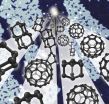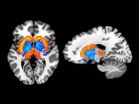(Press-News.org) G protein-coupled receptors (GPCRs) are the largest class of cell surface receptors in our cells, involved in signal transmission across the cell membrane. One of the biggest questions is how a signal recognized at the extracellular side of a GPCR induces a sequence of conformational changes in the protein and finally evokes an intracellular response. EPFL scientists have now used computer modeling to reveal in molecular detail the structural transitions that happen inside GPCRs during the signal transduction process. They discovered that a central step in the trans-membrane signaling process is the formation of a continuous water pathway inside the G protein coupled receptors. The work, published in Nature Communications, proposes that future therapeutic compounds might be selected according to their potential to interfere with the receptors' internal waters.
GPCRs amplify extracellular signals to finally evoke intracellular responses
GPCRs are membrane proteins on the cell's surface. There are approximately 800 different GPCR types, each of which can detect and bind specific molecules on the cell's surface, which are called 'ligands'. Upon binding a ligand, the GPCR transmits a signal across the cell's membrane where specialized, so-called G proteins work to amplify the signal using a cascade of biochemical reactions that evoke cellular responses.
As these processes are of central importance for the proper function of our cells, even slight malfunctions of these processes can result in severe diseases. This makes GPCRs of utmost importance as targets for modern drug development, while a large proportion of current clinical drugs target various GPCRs. Therefore, understanding how GPCRs function at a molecular level can lead to the development of novel, powerful drugs for the treatment of diseases including cancer, diabetes, neurological disorders, inflammations, immunological disorders and cardiovascular disorders.
The 3D structures of a few GPCRs have already been solved by X-ray crystallography. However, this approach generates only static structures, which are not suited to uncover the structural changes that occur within the GPCRs during the signal transduction process.
Modeling GPCRs
The team of Horst Vogel at EPFL has now used a method known as 'molecular dynamics computer simulations' to model prototypical GPCRs. The team succeeded in simulating the time course of transitions in the 3D structure of the GPCRs during the process of signal transduction across the cell membrane.
Vogel's team revealed in detail the important molecular steps of how a GPCR transmits a signal across the cell membrane. After binding a ligand on the extracellular side, the GPCR undergoes a couple of 3D changes. These then allow water molecules to enter the interior of the GPCR, reaching a 'water barrier' of amino acids.
After further structural changes, this barrier opens a gate and finally allows the formation of a continuous water channel extending from the ligand binding site to the intracellular region of the receptor. The consecutive structural changes within the receptor, combined with the water channel are essential for the activation of G proteins on the intracellular side of the GPCR. Once activated, the G proteins can then amplify the signal.
"This discovery of these internal water channels can pave the way for novel approaches in drug development," says Horst Vogel. "By searching for compounds which bind to GPCRs and modulate their water channels, it might be possible to find more efficient therapeutic compounds."
INFORMATION:
This work includes a collaboration of EPFL's Laboratory of Physical Chemistry and Membranes with the University of Warsaw (Poland) and Case Western Reserve University (USA).
Reference
Yuan S, Filipek S, Palczewski K, Vogel H. Activation of G-protein-coupled receptors correlates with the formation of a continuous internal water pathway. Nature Communications 09 September 2014. DOI: 10.1038/ncomms5733
Tracing water channels in cell surface receptors
2014-09-09
ELSE PRESS RELEASES FROM THIS DATE:
Shift in Arabia sea plankton may threaten fisheries
2014-09-09
A growing "dead zone" in the middle of the Arabian Sea has allowed plankton uniquely suited to low-oxygen water to take over the base of the food chain. Their rise to dominance over the last decade could be disastrous for the predator fish that sustain 120 million people living on the sea's edge.
Scientists at Columbia University's Lamont-Doherty Earth Observatory and their colleagues are the first to document the rapid rise of green Noctiluca scintillans, an unusual dinoflagellate that eats other plankton and draws energy from the sun via microscopic algae living within ...
Buckyballs and diamondoids join forces in tiny electronic gadget
2014-09-09
Menlo Park, Calif. — Scientists have married two unconventional forms of carbon – one shaped like a soccer ball, the other a tiny diamond – to make a molecule that conducts electricity in only one direction. This tiny electronic component, known as a rectifier, could play a key role in shrinking chip components down to the size of molecules to enable faster, more powerful devices.
"We wanted to see what new, emergent properties might come out when you put these two ingredients together to create a 'buckydiamondoid,'" said Hari Manoharan of the Stanford Institute for Materials ...
Eating habits, body fat related to differences in brain chemistry
2014-09-09
People who are obese may be more susceptible to environmental food cues than their lean counterparts due to differences in brain chemistry that make eating more habitual and less rewarding, according to a National Institutes of Health study published in Molecular Psychiatry.
Researchers at the NIH Clinical Center found that, when examining 43 men and women with varying amounts of body fat, obese participants tended to have greater dopamine activity in the habit-forming region of the brain than lean counterparts, and less activity in the region controlling reward. Those ...
Study sheds light on how stem cells can be used to treat lung disease
2014-09-09
Munich, Germany: A new study has revealed how stem cells work to improve lung function in acute respiratory distress syndrome (ARDS).
Previous studies have shown that stem cells can reduce lung inflammation and restore some function in ARDS, but experts are not sure how this occurs. The new study, which was presented at the European Respiratory Society's International Congress today (09 September 2014), brings us a step closer to understanding the mechanisms that occur within an injured lung.
ARDS is a life-threatening condition in which the efficiency of the lungs ...
Birth measurements could predict lung health in teen years
2014-09-09
Munich, Germany: A new study has found that factors, such as birth weight, gestational age at birth and lung function, growth and other measures at 8 years, can be used to predict lung function during mid to late teenage years.
The study, presented at the European Respiratory Society (ERS) International Congress in Munich today (9 September 2014), is part of a growing area of research aiming to understand how early life factors have an impact on the development of disease into adulthood.
Data out of the Avon Longitudinal Study of Mothers and Children (ALSPAC) from ...
Idiopathic pulmonary fibrosis cases linked with asbestos exposure
2014-09-09
Munich, Germany: A proportion of idiopathic pulmonary fibrosis (IPF) cases may be linked with asbestos exposure, according to the results of a new study. If confirmed, the findings would mean that current treatment strategies need to be altered as people with a history of asbestos exposure are not currently able to access new treatments for IPF.
The research, which was presented at the European Respiratory Society's International Congress today (09 September 2014), provided new mortality data for IPF, asbestosis and mesothelioma.
Asbestosis is the name given to the ...
Milestone reached in work to build replacement kidneys in the lab
2014-09-09
WINSTON-SALEM, N.C. – Sept. 9, 2014 – Regenerative medicine researchers at Wake Forest Baptist Medical Center have addressed a major challenge in the quest to build replacement kidneys in the lab. Working with human-sized pig kidneys, the scientists developed the most successful method to date to keep blood vessels in the new organs open and flowing with blood. The work is reported in journal Technology.
"Until now, lab-built kidneys have been rodent-sized and have functioned for only one or two hours after transplantation because blood clots developed," said Anthony ...
Intervention in 6-month-olds with autism eliminates symptoms, developmental delay
2014-09-09
Treatment at the earliest age when symptoms of autism spectrum disorder (ASD) appear – sometimes in infants as young as 6 months old – significantly reduces symptoms so that, by age 3, most who received the therapy had neither ASD nor developmental delay, a UC Davis MIND Institute research study has found.
The treatment, known as Infant Start, was administered over a six-month period to 6- to 15-month-old infants who exhibited marked autism symptoms, such as decreased eye contact, social interest or engagement, repetitive movement patterns, and a lack of intentional communication. ...
Contrast-enhanced CT scan safe for most patients
2014-09-09
OAK BROOK, Ill. – According to new research performed at the Mayo Clinic, iodine-based contrast material injected intravenously to enhance computed tomography (CT) images can be safely used in most patients. The study appears online in the journal Radiology.
Of the 80 million or more CT scans performed each year in the United States, iodine-based contrast material is used in at least half to enhance computed tomography (CT) images, according to researcher Robert J. McDonald, M.D., Ph.D., a radiology resident at the Mayo Clinic in Rochester, Minn.
According to Dr. McDonald, ...
IU study links skipping school, failing tests to more sex, less condom use in teenagers
2014-09-09
INDIANAPOLIS -- What do skipping school, failing tests and engaging in risky sexual behavior have in common? Lots, according to Indiana University researchers who combed through 80,000 diary entries written by 14- to 17-year-old girls.
Although the findings are intuitive, this is the first study to examine the day-to-day relationship between teenage girls' reports about school-related events, how they felt and the sexual behaviors they participated in. Published Sept. 9 in the Journal of Adolescent Health, the findings are based on a 10-year study of the development of ...


